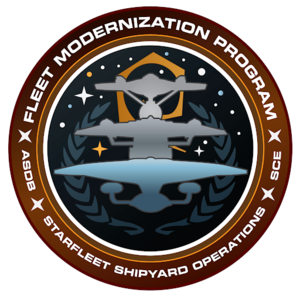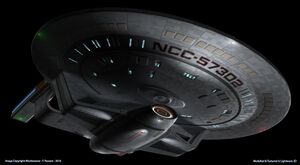Fleet Modernization Program (2340s)
The Fleet Modernization Program (FMP) of the 2340s and '50s was an initiative of the Advanced Starship Design Bureau, Starfleet Shipyard Operations, and the Starfleet Corps of Engineers to develop a number of new starship classes to bring the advancements pioneered by the Ambassador-class into widespread use across Starfleet. This program would culminate in the development of the Galaxy-class explorer, first launched in the late 2350s. This program did not see full completion, as the Battle of Wolf 359 prompted a rapid pivot towards designs that were combat hardened in the late 2360s.
Background
By 2340, the Ambassador-class heavy cruiser had entered service as the largest and most powerful Federation starship ever constructed, with innovations in nearly every system, but especially the warp drive and defensive systems. These units were few and far between, though, with the fleet still being made up largely of Excelsior, Miranda, Constellation, and Oberth-class starships, the latter three of which relied on technology developed in the 2270s, even as more modern systems were added in piecemeal. They were built because they were proven, reliable designs, but they were starting to lag behind the technological innovations being developed by the Corps of Engineers, and there were limits to how many new technologies could successfully be integrated into these designs, especially considering that the Miranda's original configuration dated back to the 2250s!
Within Starfleet Command, there was extreme reluctance to change course, given that the majority of the fleet's senior leaders had cut their teeth on these legacy classes, and so it took concerted lobbying on the part of the Advanced Starship Design Bureau to receive permission to try something new: most of the time, Starfleet had preferred to develop a flagship class (such as the Constitution or Excelsior) first to allow other classes to be derived from these large, expensive designs, but the ASDB proposed doing the opposite instead. This time around, smaller classes would be developed that would incrementally introduce the innovations that would culminate in the flagship design: the Galaxy-class, which had long been in the works as the eventual Ambassador-class successor.
This program would develop a science vessel, a scout, a light cruiser, and a frigate, each of which would be modern, highly-capable, and superior to the aging starships that fulfilled those roles in the 2330s and 2340s. This would be Phases One and Two, with Phase Three being the construction of the Galaxy-class and Nebula-class starships which would supplant the Ambassador and Excelsior, resulting in a full complement of new starship designs on the books by 2360. Late in the process, it the California-class utility cruiser was added to Phase Three as well.
Phase One (2342-2345)
The first and most visible part of the FMP was to settle on a common hull geometry and construction process for this new wave of ships. Rather than a circular primary hull (as was present on every previous major Starfleet class to that point), it was decided instead to use an elliptical design. This design would allow for more compartments in the primary hull to have viewports, the lack of which was a common complaint among crew members. In addition, the interlocking structural framework that was designed to support this elliptical structure would be the strongest space frame ever developed. The two ships in this phase would test competing primary hull designs: the Cheyenne a shape first debuted aboard the Constitution-class with roughly symmetrical dorsal and ventral surfaces where the rim of the saucer was narrower than the center; and the Springfield a wholly-new design where the dorsal surface's taper was much more gradual, thus providing more space.
Engine systems would be enhanced versions of those used aboard the Ambassador-class: the class-five warp core and fully-independent fusion-driven impulse engines, the latter of which were considered especially important, as designs derived from the Constitution-class refit of the 2270s relied on a combination warp-impulse reaction assembly that had benefits when it came to fuel efficiency, but which led to an extremely complex internal reactor structure, as well as meaning that primary power failure meant the failure of both warp and impulse systems.
Springfield-class Science Vessel (2345)
Main Article: Springfield-class Science Vessel
The Springfield-class starship was the first vessel to be produced as part of the FMP. It served as the testbed for one of two competing primary hull designs (the other being tested on the Cheyenne-class) and of a modular pod system that served as the basis of the pod used later on the Nebula-class.
Cheyenne-class Light Cruiser (2345)
Main Article: Cheyenne-class Light Cruiser
The Cheyenne-class light cruiser was developed as a successor to the Constellation-class cruiser, using the same four-nacelle design to increase endurance. This class was the first purpose-built class that could separate its primary and secondary hulls and reconnect them without starbase support or extended downtime, as well as an alternate primary hull arrangement.
Phase Two (2345-2352)
With the Springfield and Cheyenne-class vessels in production and undergoing rigorous shakedown operations, Phase Two commenced with the Challenger-class and New Orleans-class designs.

